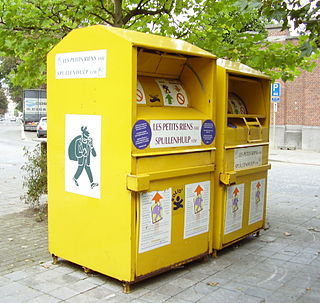Spinning is a twisting technique to form yarn from fibers. The fiber intended is drawn out, twisted, and wound onto a bobbin. A few popular fibers that are spun into yarn other than cotton, which is the most popular, are viscose, animal fibers such as wool, and synthetic polyester. Originally done by hand using a spindle whorl, starting in the 500s AD the spinning wheel became the predominant spinning tool across Asia and Europe. The spinning jenny and spinning mule, invented in the late 1700s, made mechanical spinning far more efficient than spinning by hand, and especially made cotton manufacturing one of the most important industries of the Industrial Revolution.

Yarn is a long continuous length of interlocked fibres, used in sewing, crocheting, knitting, weaving, embroidery, ropemaking, and the production of textiles. Thread is a type of yarn intended for sewing by hand or machine. Modern manufactured sewing threads may be finished with wax or other lubricants to withstand the stresses involved in sewing. Embroidery threads are yarns specifically designed for needlework. Yarn can be made of a number of natural or synthetic materials, and comes in a variety of colors and thicknesses. Although yarn may be dyed different colours, most yarns are solid coloured with a uniform hue.

Linen is a textile made from the fibers of the flax plant.

Wool classing is the production of uniform, predictable, low-risk lines of wool, carried out by examining the characteristics of the wool in its raw state and classing (grading) it accordingly. Wool classing is done by a wool classer.

Metallic fibers are manufactured fibers composed of metal, metallic alloys, plastic-coated metal, metal-coated plastic, or a core completely covered by metal.

The textile industry is primarily concerned with the design, production and distribution of textiles: yarn, cloth and clothing. The raw material may be natural, or synthetic using products of the chemical industry.

Textile fibers, threads, yarns and fabrics are measured in a multiplicity of units.

Textile recycling is the process of recovering fiber, yarn, or fabric and reprocessing the material into new, useful products. Textile waste is split into pre-consumer and post-consumer waste and is sorted into five different categories derived from a pyramid model. Textiles can be either reused or mechanically/chemically recycled.
A staple fiber is a textile fiber of discrete length. The opposite is a filament fiber, which comes in continuous lengths. Staple length is a characteristic fiber length of a sample of staple fibers. A fiber is made up of natural substances and is known for being longer than it is wide. It is an essential criterion in yarn spinning, and aids in cohesion and twisting. Compared to synthetic fibers, natural fibers tend to have different and shorter lengths. The quality of natural fibers like cotton is categorized into staple length such as short, medium, long staple, and extra-long. Gossypium barbadense, one of several cotton species, produces extra-long staple fibers. The staple fibers may be obtained from natural and synthetic sources. In the case of synthetics and blends, the filament yarns are cut to a predetermined length.
An S number on the label of wool suits or other tailored apparel, wool fabric, or yarn, indicates the fineness of the wool fiber used in the making of the apparel, as measured by its maximum diameter in micrometres. Fiber fineness is one of the factors determining the quality and performance of a wool product. In recent years it has also become an important marketing device used by many mills, garment makers, and retailers. The S number appears as a plural with an s or 's following the number, such as 100s or 100's.

Ring spinning is a spindle-based method of spinning fibres, such as cotton, flax or wool, to make a yarn. The ring frame developed from the throstle frame, which in its turn was a descendant of Arkwright's water frame. Ring spinning is a continuous process, unlike mule spinning which uses an intermittent action. In ring spinning, the roving is first attenuated by using drawing rollers, then spun and wound around a rotating spindle which in its turn is contained within an independently rotating ring flyer. Traditionally ring frames could only be used for the coarser counts, but they could be attended by semi-skilled labour.
Cotton classing is the measurement and classification of cotton by its specific physical attributes. This information is attached to individual bales, thus clarifying their value and helping producers market them. For cotton buyers, i.e. the spinning mills, this precise information about the cotton fiber enables them to achieve consistent yarn quality by optimizing raw material selection and blending.
Dimensional stability pertains to a fabric's ability to maintain its initial size and shape even after undergoing wear and care, which is a desirable property. Dimension stability in fabrics or Shrinkage is the change of dimensions in textile products when they are washed or relaxed. The change is always expressed relative to the dimensions before the exposure of washing or relaxing. Shrinkage is also called residual shrinkage and measured in percentage. The major cause of shrinkages is the release of stresses and strains introduced in manufacturing processes. Textile manufacturing is based on the conversion of fiber into yarn, yarn into fabric, includes spinning, weaving, or knitting, etc. The fabric passes through many inevitable changes and mechanical forces during this journey. When the products are immersed in water, the water acts as a relaxing medium, and all stresses and strains are relaxed and the fabric tries to come back to its original state.

Cotton recycling is the process of converting cotton fabric into fibers that can be reused into other textile products.
The textile industry is the largest manufacturing industry in Pakistan. Pakistan is the eighth largest exporter of textile commodities in Asia. Textile sector contributes 8.5% to the GDP of Pakistan. In addition, the sector employs about 45% of the total labor force in the country. Pakistan is the fourth largest producer of cotton with the third largest spinning capacity in Asia after China and India and contributes 5% to the global spinning capacity. At present, there are 1,221 ginning units, 442 spinning units, 124 large spinning units and 425 small units which produce textile.

Jakob Heusser-Staub was a Swiss industrialist and philanthropist. Born and raised in the village of Irgenhausen, Heusser-Staub made Uster his home. With the support of his wife, Berta, he founded the Heusser-Staub foundation.
Bahauddin Zakariya University College of Textile Engineering, also known as BZU college of textile engineering, is an institute in southern Punjab, which provides engineering degrees in the field of textile. It is situated on 6-km Khanewal road in Multan, Pakistan.

Cotton maturity is a physical testing parameter of cotton fiber properties testing. It is quantified by the degree of cell wall thickening relative to its perimeter. The maturity of individual cotton fiber is an essential aspect of the cotton classing regarding the aesthetics such as appearance, dye-uptake, etc. High volume instrument (HVI) can test cotton maturity like many other fiber properties, including length, uniformity, micronaire/fineness, strength, color, etc.
In textile spinning, yarn realisation (YR), or yarn recovery, is an operational parameter of yarn manufacturing. It is the percentage conversion of raw material to finished yarn. The rest of the waste fibers with less value are compared to the weight of the produced yarn from a given weight of raw material. The quantity of waste removed during the various phases of yarn spinning, such as blow-room, carding, and combing, is often used to determine yarn realisation. Yarn realisation ranges between 85% and 90% in carded cotton yarns and between 67% and 75% in combed cotton yarns.

Textile testing is the process of measuring the properties and performance of textile materials—textile testing includes physical and chemical testing of raw materials to finished products.












